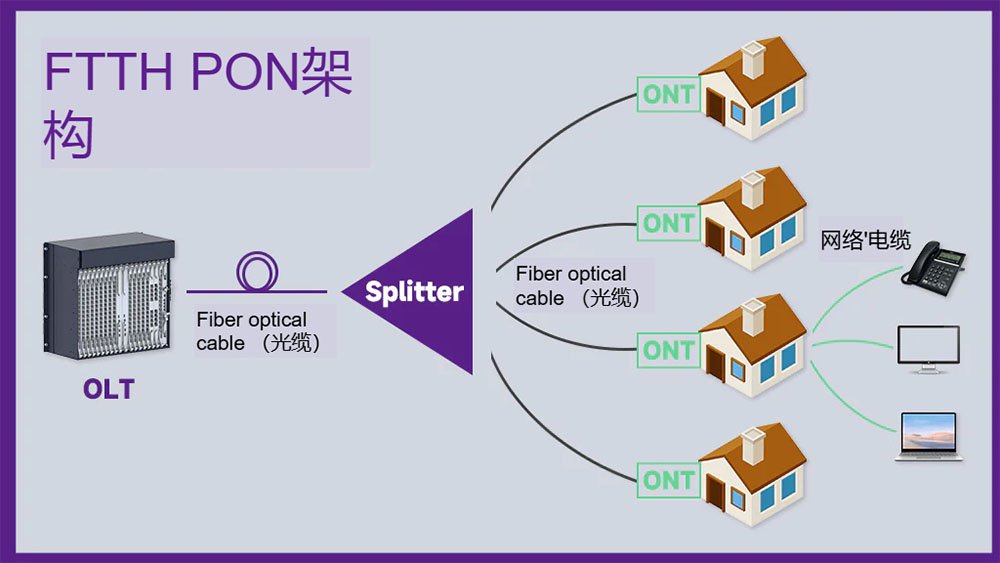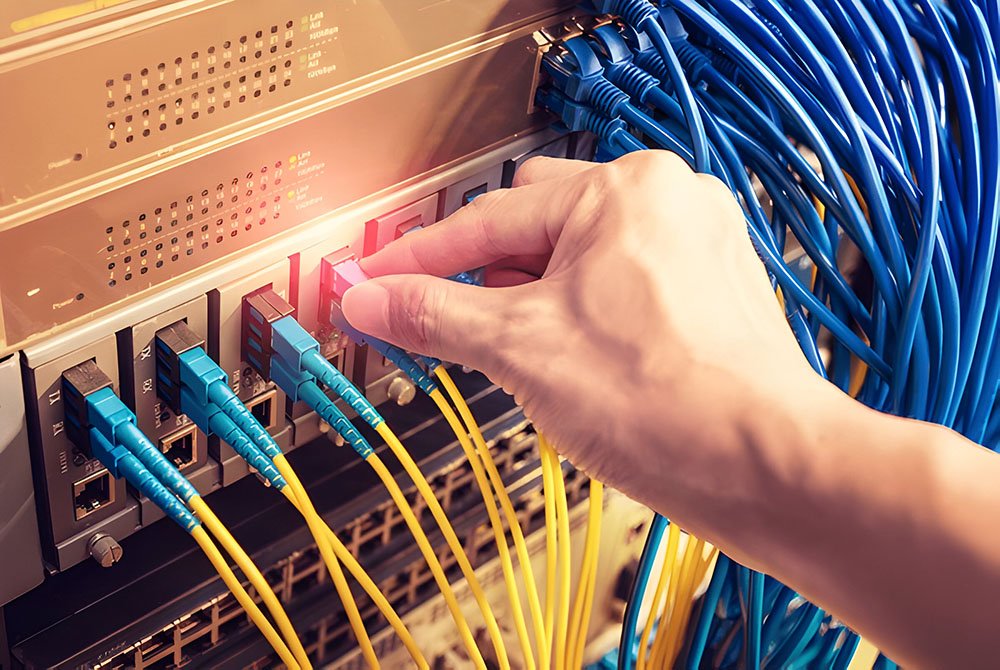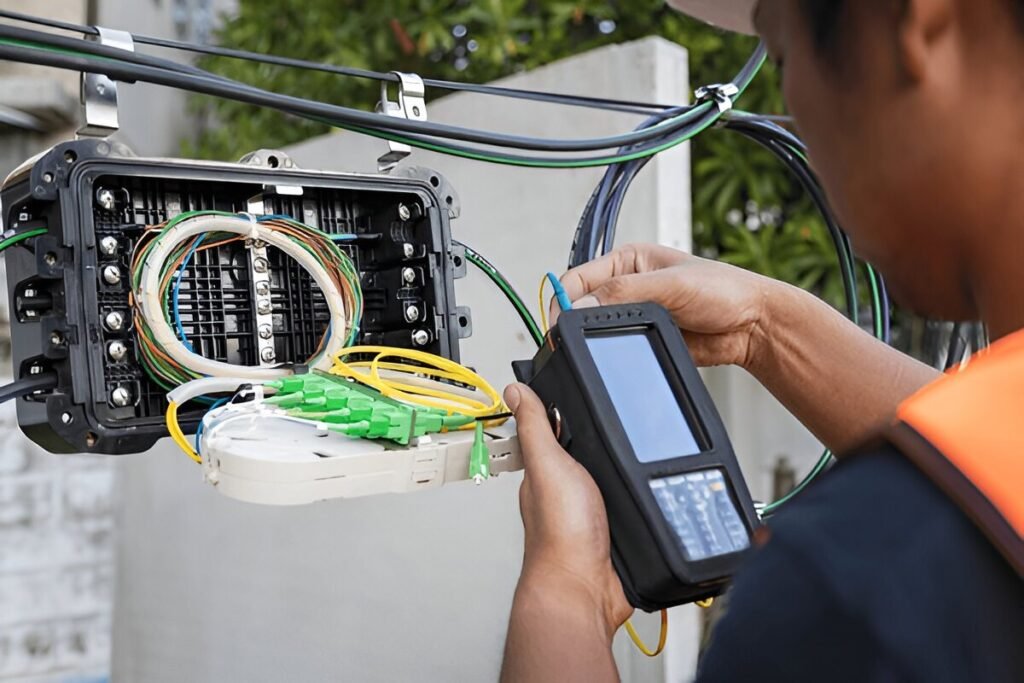Have you ever heard the term FTTH and wondered, what is FTTH? It stands for Fiber to the Home, and it’s a cutting-edge method for delivering super-fast internet right to your house. Imagine streaming 4K movies, gaming without any lag, and working from home—all at the same time—without your connection ever slowing down. That’s the kind of experience FTTH internet can offer! In this beginner-friendly guide, we’ll dive deep into what is FTTH, exploring how this method works, what it involves, its benefits, and how it compares to other fiber delivery approaches. We’ll keep it simple and easy to follow, so you can see why FTTH benefits are transforming the way we connect. With solutions from CommMesh, let’s get started on understanding FTTH fiber optic delivery and why it might be the perfect choice for your internet needs!
What Is FTTH and How Does It Work as a Delivery Method?

Defining FTTH
So, what is FTTH? FTTH, which means Fiber to the Home, is a method of delivering internet where fiber optic cables are extended directly from the internet service provider (ISP) to your individual home. Unlike other methods that might stop fiber at a certain point—like a building or a street cabinet—and use copper wires for the final stretch, FTTH fiber optic delivery ensures the fiber reaches your house—giving you the full power of fiber technology—e.g., 1 Gbps speeds for a typical household.
The Process of FTTH Internet Delivery
Here’s how FTTH internet works as a delivery method: the ISP starts with a central hub—e.g., a 50 km fiber backbone—where data, like a video stream, is converted into light signals using a laser—e.g., at 1310 nm wavelength. These signals travel through fiber optic cables all the way to your home—e.g., 1 km with just 0.2 dB/km signal loss. At your house, a device called an ONT (Optical Network Terminal)—e.g., a $100 box—converts the light signals back into data—e.g., 1 Gbps for your Wi-Fi router—connecting all your devices like laptops, TVs, and smart speakers.
Why FTTH Uses Fiber All the Way
The defining feature of FTTH fiber optic delivery is its use of fiber optics for the entire connection path to your home—no copper wires are involved at any point. This all-fiber method allows FTTH internet to deliver high speeds over long distances—e.g., 1 Gbps over 20 km with 0.4 dB loss—without needing extra equipment to boost the signal. Other methods might use copper for the final stretch—e.g., losing 10 dB/km—leading to slower speeds—e.g., 100 Mbps at 500m—making what is FTTH a key question for anyone wanting the best internet experience.
The Reliability of an All-Fiber Method
Since FTTH fiber optic delivery uses fiber all the way to your home, the connection is immune to electromagnetic interference—e.g., no signal drop near power lines—unlike methods that use copper, which can lose 20% of their signal in noisy environments. This reliability—e.g., 99.99% uptime—ensures FTTH internet keeps you connected, whether you’re in a busy city or a rural area, making it a top choice for modern connectivity needs.
What Does an FTTH Network Setup Involve?
To fully understand what is FTTH, let’s break down the key elements involved in setting up an FTTH fiber optic delivery method.
Optical Line Terminal (OLT)
The ISP’s Starting Point
The OLT is the starting point, located at the ISP’s central office—e.g., a $5000 unit managing 128 homes. It’s where the ISP converts data into light signals—e.g., 2.5 Gbps downstream—and sends them through the fiber network—e.g., a 50 km backbone with 0.2 dB/km loss—beginning the journey to your home.

Fiber Optic Backbone
The Main Network Pathway
The fiber optic backbone is a network of cables—e.g., single mode with a 9-micron core—that carries light signals from the OLT toward your neighborhood—e.g., 20 km with 0.4 dB loss. These cables are made of ultra-pure glass—e.g., 99.999% silica—ensuring minimal signal loss, which is crucial for FTTH fiber optic delivery.
Optical Splitters
Distributing the Signal
Splitters divide the signal to serve multiple homes—e.g., a 1:32 splitter for $20—allowing 32 houses to share 2.5 Gbps. They’re often placed in cabinets—e.g., 500m from homes—making FTTH internet efficient by reducing the need for separate cables to each house—e.g., saving $5000/km in installation costs.
Drop Cables to the Home
The Final Fiber Connection
Drop cables are the final fiber optic cables—e.g., a 100m single mode cable—that run from the splitter directly to your home—e.g., $100 with a fiber optic cable splice. This direct fiber connection to the home is what defines FTTH fiber optic delivery—ensuring the signal reaches your house without any copper—e.g., maintaining 1 Gbps.
Optical Network Terminal (ONT)
Your Home’s Connection Hub
The ONT—e.g., a $100 device—sits in your home, converting light signals back into data—e.g., 1 Gbps for your router. It’s small—e.g., the size of a book—and connects via Ethernet—e.g., to your Wi-Fi—delivering FTTH benefits like high-speed streaming to all your devices—CommMesh supplies these cables.

What Can FTTH Internet Enable for Users?
Let’s explore what can FTTH internet enable—because FTTH internet opens up a wide range of possibilities for how you live, work, and play.
Streaming High-Quality Content
4K Movies Without Buffering
With FTTH fiber optic delivery, you can stream 4K movies on multiple devices—e.g., 1 Gbps supporting 5 TVs—without buffering—e.g., a 2-hour 4K movie downloads in 30 seconds—perfect for movie nights or binge-watching your favorite series.
Lag-Free Online Gaming
Smooth Gameplay
Gamers will love FTTH benefits—e.g., 5 ms latency—ensuring no lag in fast-paced games—e.g., a 50 GB game downloads in 6 minutes at 1 Gbps—making FTTH internet a dream for competitive players who need quick response times.
Seamless Remote Work
Flawless Video Calls
FTTH internet supports remote work—e.g., 1 Gbps for 10 Zoom meetings—without glitches—e.g., 1080p video with zero lag—perfect for professionals needing reliable connections for video calls, file transfers, and cloud apps.
Smart Home Connectivity
Managing All Devices
Smart homes thrive with FTTH fiber optic delivery—e.g., 1 Gbps for 20 devices like cameras and thermostats—ensuring real-time control—e.g., 99.99% uptime—perfect for managing everything from lights to security systems seamlessly.
Telemedicine and Online Learning
High-Quality Interactions
FTTH internet enables telemedicine—e.g., 1 Gbps for HD medical imaging—e.g., zero interference—for clear doctor consultations. In education, it supports online learning—e.g., 500 Mbps for 50 students—e.g., 4K lectures without buffering—enhancing virtual classrooms.

What Are the Benefits of Choosing FTTH?
Let’s break down the FTTH benefits—because understanding why FTTH internet is so great is a big part of what is FTTH.
Lightning-Fast Speeds
Up to 10 Gbps
FTTH fiber optic delivery offers speeds up to 10 Gbps—e.g., 1 Gbps steady—perfect for heavy users—e.g., downloading a 50 GB file in 6 minutes—making FTTH benefits ideal for families with multiple devices online at once.
Reliable Over Long Distances
Consistent Performance
FTTH internet maintains speed over distance—e.g., 1 Gbps over 20 km with 0.4 dB loss—ensuring FTTH fiber optic delivery works in rural areas—e.g., 99.99% uptime—perfect for homes far from the ISP’s hub.
Super Low Latency
Quick Response Times
FTTH benefits include low latency—e.g., 5 ms—great for gaming and video calls—e.g., 1 ms reaction time in games—making FTTH internet highly responsive for real-time applications like live streaming or online meetings.
Future-Proof Connectivity
Ready for Tomorrow
FTTH fiber optic delivery is future-proof—e.g., upgrading to 10G PON without new cables—saving $5000/km vs. rewiring—ensuring FTTH benefits last—e.g., supporting 60% global fiber demand by 2030 (Statista).
Energy Efficiency
Saving Power
FTTH internet uses less energy—e.g., 1 W per km vs. 10 W for methods with copper—reducing costs—e.g., 90% less CO2 for a 10 km link—making FTTH fiber optic delivery eco-friendly—e.g., $100/year savings on power.

How Much Does FTTH Internet Cost?
Let’s talk about the cost of FTTH internet—because understanding expenses helps answer what is FTTH.
Installation Costs for ISPs
Building the Network
For ISPs, a 50 km fiber backbone—$0.50/m—costs $25,000—plus $5000/km labor—e.g., $275,000 total—for 5000 homes—$55/home. Drop cables—e.g., $100 each—add $500,000—plus OLT ($5000) and ONTs ($100 each)—e.g., $505,000—totaling $1.3 million—$260/home.
Monthly Costs for Users
Subscription Plans
For users, FTTH internet might0/month for 1 Gbps—e.g., $600/year—offering FTTH benefits like 1 Gbps steady—e.g., 4K streaming on 5 devices—making it a worthwhile investment for high-speed needs.
Long-Term Savings
Lower Maintenance
FTTH fiber optic delivery saves money long-term—e.g., $1000/km maintenance vs. $10,000/km for copper-heavy methods—recouping $1.3 million in 5 years—making FTTH internet cost-effective—e.g., $5000/km savings on upgrades.

How Does FTTH Compare to Other Fiber Delivery Methods?
Let’s compare FTTH internet to other fiber optic delivery methods—because what is FTTH becomes clearer when you see how it stacks up against FTTA, FTTB, FTTC, FTTD, FTTE, FTTN, FTTO, FTTP, and FTTR.
FTTH vs. FTTA (Fiber to the Antenna)
Purpose and Reach
FTTH fiber optic delivery brings internet to homes—e.g., 1 Gbps to a house—while FTTA extends fiber to cell towers—e.g., 10 Gbps for 5G networks—supporting mobile data—e.g., 1 million users per tower. FTTH benefits focus on residential use—e.g., 5 ms latency for gaming—while FTTA prioritizes wireless coverage—e.g., 99.9% uptime for mobile signals.
Infrastructure Needs
FTTH internet requires fiber to each home—e.g., $260/home—while FTTA stops at the tower—e.g., $5000/tower—serving many users—e.g., 10 km radius—making FTTA cheaper for ISPs but less direct for home users—e.g., 20 ms latency via 5G.
FTTH vs. FTTB (Fiber to the Building)
Connection Point
FTTH fiber optic delivery goes to each home—e.g., 1 Gbps per house—while FTTB stops at a building—e.g., an apartment—using copper for the last stretch—e.g., 500 Mbps per unit. FTTH benefits include dedicated speed—e.g., 1 Gbps steady—while FTTB shares bandwidth—e.g., 200 Mbps during peak hours.
Cost and Scalability
FTTH internet costs more—e.g., $260/home—vs. FTTB’s $100/unit—e.g., $1000 for a 10-unit building—but offers better performance—e.g., 99.99% uptime—while FTTB’s copper segment can lose 10% signal—e.g., in a 100m run—making FTTH ideal for future-proofing.
FTTH vs. FTTC (Fiber to the Curb)
Last Mile Difference
FTTH fiber optic delivery reaches your home—e.g., 1 Gbps over 1 km—while FTTC stops at a curb cabinet—e.g., 500m away—using copper for the final stretch—e.g., 100 Mbps at 500m due to 10 dB/km loss. FTTH benefits ensure full fiber speed—e.g., 0.2 dB/km loss—while FTTC degrades—e.g., 20% signal drop.
Installation and Availability
FTTH internet is pricier—e.g., $260/home—vs. FTTC’s $50/home—e.g., $250,000 for 5000 homes—but offers better reliability—e.g., 99.99% uptime—while FTTC’s copper can fail—e.g., 20% storm loss—making FTTH the premium choice where available—e.g., 50% U.S. coverage (2023 FCC).
FTTH vs. FTTD (Fiber to the Desktop)
End Point
FTTH fiber optic delivery stops at the home—e.g., 1 Gbps to the ONT—while FTTD extends fiber to individual desktops—e.g., 10 Gbps per workstation—typically in offices. FTTH benefits suit homes—e.g., 5 ms latency—while FTTD is for high-performance business setups—e.g., 1 ms latency.
Use Case
FTTH internet serves residential users—e.g., $50/month for 1 Gbps—while FTTD targets enterprises—e.g., $500/month for 10 Gbps—offering higher speeds but at a higher cost—e.g., $1000/installation—making FTTH more practical for home use.
FTTH vs. FTTE (Fiber to the Enclosure)
Connection Scope
FTTH fiber optic delivery reaches each home—e.g., 1 Gbps per house—while FTTE stops at an enclosure—e.g., a telecom cabinet—using copper or Ethernet—e.g., 500 Mbps per user. FTTH benefits provide direct fiber—e.g., 0.2 dB/km loss—while FTTE’s last mile can lose 10% signal—e.g., 100m copper run.
Deployment
FTTH internet requires more fiber—e.g., $260/home—vs. FTTE’s $150/enclosure—e.g., $1500 for 10 homes—but ensures better performance—e.g., 99.99% uptime—while FTTE is simpler for ISPs—e.g., 50% less fiber—making FTTH better for end-user speed.
FTTH vs. FTTN (Fiber to the Node/Neighborhood)
Distance to Fiber
FTTH fiber optic delivery goes to the home—e.g., 1 Gbps over 1 km—while FTTN stops at a node—e.g., 1 km away—using copper—e.g., 50 Mbps at 1 km due to 10 dB/km loss. FTTH benefits ensure full fiber speed—e.g., 0.2 dB/km loss—while FTTN degrades—e.g., 30% signal drop.
Cost Efficiency
FTTH internet costs more—e.g., $260/home—vs. FTTN’s $30/home—e.g., $150,000 for 5000 homes—but offers better reliability—e.g., 99.99% uptime—while FTTN’s copper can fail—e.g., 20% storm loss—making FTTH the better long-term choice.
FTTH vs. FTTO (Fiber to the Office)
Target User
FTTH fiber optic delivery serves homes—e.g., 1 Gbps per house—while FTTO targets offices—e.g., 10 Gbps per office—using fiber to the office space. FTTH benefits suit residential needs—e.g., 5 ms latency—while FTTO is for businesses—e.g., 1 ms latency for servers.
Bandwidth Allocation
FTTH internet provides dedicated speed—e.g., $50/month for 1 Gbps—while FTTO offers higher bandwidth—e.g., $500/month for 10 Gbps—but at a higher cost—e.g., $2000/installation—making FTTH more affordable for home users.
FTTH vs. FTTP (Fiber to the Premises)
Scope of Delivery
FTTH fiber optic delivery is a subset of FTTP, focusing on homes—e.g., 1 Gbps per house—while FTTP includes homes, businesses, and other premises—e.g., 1 Gbps to a school. FTTH benefits are residential-focused—e.g., 99.99% uptime—while FTTP is broader—e.g., 99.9% uptime for mixed use.
Implementation
FTTH internet and FTTP are similar in cost—e.g., $260/home—but FTTP may serve more diverse users—e.g., $500/business—offering flexibility—e.g., 10 Gbps for schools—while FTTH is tailored for homes—e.g., 1 Gbps for families.
FTTH vs. FTTR (Fiber to the Room)
Granularity
FTTH fiber optic delivery stops at the home—e.g., 1 Gbps to the ONT—while FTTR extends fiber to each room—e.g., 1 Gbps per room—using in-home fiber. FTTH benefits suit general home use—e.g., 5 ms latency—while FTTR is for ultra-high-speed room-specific needs—e.g., 1 ms latency.
Complexity
FTTH internet is simpler—e.g., $260/home—vs. FTTR’s $500/home—e.g., $100/room for 5 rooms—but FTTR offers more precision—e.g., 1 Gbps per room—while FTTH is more practical for most homes—e.g., 1 Gbps shared.

Why Is FTTH the Future of Internet Delivery?
Let’s wrap up what is FTTH by looking at why this method is the future of internet delivery.
Meeting Growing Data Demands
Supporting More Devices
FTTH fiber optic delivery handles growing data needs—e.g., 1 Gbps for 20 devices—supporting smart homes—e.g., 100 TB yearly traffic—while other methods struggle—e.g., FTTN’s 50 Mbps for 5 devices—making FTTH benefits essential for modern households.
Enabling New Technologies
5G and IoT
FTTH internet supports emerging tech—e.g., 10 Gbps for 5G backhaul—enabling IoT—e.g., 1 million connected devices per km²—while FTTB or FTTC can’t keep up—e.g., 500 Mbps limits—positioning FTTH fiber optic delivery as the backbone for innovation.
Global Expansion Trends
Rising Adoption
FTTH benefits are driving adoption—e.g., 60% global fiber connections by 2030 (Statista)—as ISPs invest—e.g., $1.3 million for 5000 homes—because FTTH internet offers unmatched reliability—e.g., 99.99% uptime—making it the go-to choice worldwide.
Conclusion: Why FTTH Matters for Your Connectivity
What is FTTH? It’s the ultimate method to bring light-speed internet to your home—like a direct line to the digital world. We’ve explored FTTH fiber optic delivery—from how it works to its components, uses, benefits, costs, and comparisons—showing why FTTH internet stands out. With FTTH benefits like 1 Gbps speeds and 99.99% uptime—backed by CommMesh at $0.50/m—FTTH is the future of connectivity. Whether you’re streaming, gaming, or building a smart home, FTTH internet has you covered—make the switch and experience the difference!

